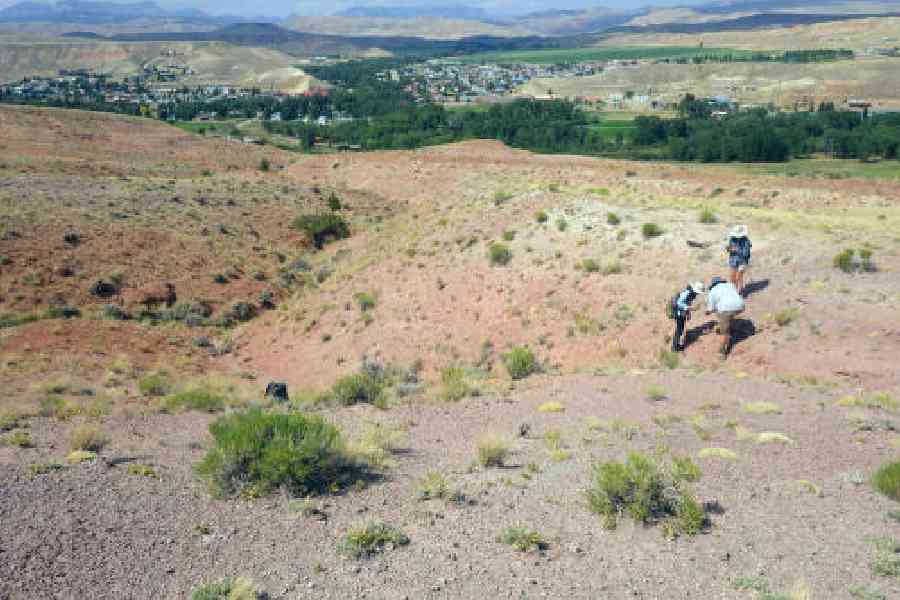At age six, Reba Teran lost the ability to speak her language. Like many Indigenous students in the 20th century, she attended schools where any language other than English was forbidden.
For the past 22 years, Teran, an Eastern Shoshone Elder, has made it her “life’s work” to build a dictionary of her people’s language, one that includes audio recordings of people speaking the words. After six years of hearing the language, she started dreaming in Eastern Shoshone.
“And then one morning,” she explained, “I woke up and all of a sudden, I could talk”. She had regained the ability to think and converse in the language.
Teran’s work on the dictionary continues and now Eastern Shoshone words she helped document are being used for the name of a new prehistoric amphibian species. That animal once burrowed for safety in the land that is home to the Eastern Shoshone.
Scientists announced the ancient amphibian, which Teran named Ninumbeehan dookoodukah, in a paper published in October in the Proceedings of the Royal Society B.
It belonged to a primitive group called temnospondyls. And it was small, its skull fitting in the palm of a hand, with scores of tiny teeth lining its mouth. During the period in which it lived — approximately 247 million to 231 million years ago — it was exposed to devastating equatorial heat and megamonsoons.
The animals’ strategy was to dig into the ground and wait till things got better. As aquatic creatures, preventing desiccation would have been key to their survival. This led the team to hypothesise that Ninumbeehan remained in their burrows until it rained again, avoiding the lethal Triassic heat in what is now Wyoming.
A key clue that Ninumbeehan was an aquatic amphibian was canals in the skull called lateral line sulci. Most fish today have the same canals and they are lined with tiny cells with hairs.
The process of naming the fossilised amphibian began after a field trip to the fossil sites that included seventh-grade students of the same Fort Washakie School that Teran once attended and where she now teaches.
They were joined by palaeontologists and Eastern Shoshone Elders. This trip stemmed from remote discussions about palaeontology organised by David Lovelace, an author on the paper and a palaeontologist at the University of Wisconsin Geology Museum, US.
Teran proposed to name them after Ninumbee, who are Little People. She described them as spiritual beings in the physical world that can be “reclusive” and sometimes “naughty”, but who can help others “through spiritual ceremony”. Naming this new species after them was a way of honouring them. “Because it was found in their territory,” she said.
The “han” of Ninumbeehan, she explained, is the possessive form. “What you’re saying is ‘Ninumbee’s’ dookoodukah’ or ‘flesh-eater’.” She explained that dookoodukah is a nod to the “little sharp teeth”, because to Teran, this new amphibian “looks like a miniature T. rex”.
Words in Eastern Shoshone, said Amanda LeClair-Diaz, an author of the study and the Indian education coordinator in the Fremont County School District No. 21, don’t always have a direct translation in English. Eastern Shoshone is “more descriptive”, LeClair-Diaz said.
Thus, dookoodukah isn’t just a reference to the teeth, it’s also a way of referring to a pet. That’s how Teran envisioned this new species: Ninumbee’s pet.
LeClair-Diaz said that creating an Eastern Shoshone name and including students in the naming process are significant.
“There’s a lot of research out there that says if students are able to see themselves or see a part of themselves in the curriculum and they’re able to connect to that, that’s really important,” she said. Education, she added, “historically hasn’t been a welcoming place for Native language, identity or culture”.
Instead, LeClair-Diaz said, the goal has been to erase it. She is working to change that in her position at the school district. “There’s a tendency to come into communities, do research, take the research, leave and then publish,” she added.
NYTNS











